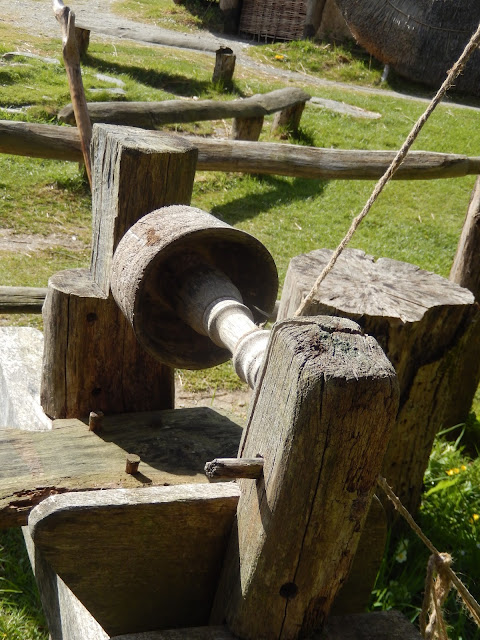Haia Pawb
One of the reasons I travelled to Britain in 2013 was to conduct research for my dark ages novel. I had a few sites in mind, which I then visited (or not, as explained in my post about Dinas Emrys). However, after my return to Australia I discovered more places I would like to visit, if I ever had the chance to come back.
The residency at Stiwdio Maelor came when I least expected such an opportunity and in the last week of my time there I picked up a hire car for the research phase of my trip. My posts about Cader Idris and Dinas Emrys describe two early research outings, but on the actual day I picked up the car I decided to visit Castell Henllys ('castle of the old court'), a reconstructed Iron Age village built on the site of an ancient village.
For my novel I plan to set a number of scenes in roundhouses, situated in various parts of the island, so I welcomed the chance to visit roundhouses built in the traditional way. Castell Henllys has four, plus a granary that is built off the ground, unlike the others. All of them have been reconstructed on their original foundations, with the upright poles that support the roof of each roundhouse having been placed into the original post holes. The size of each roundhouse has been gauged from the remains of drainage ditches.
One thing I noticed was the different levels of finish between what was termed the Chieftain’s Hut and the other roundhouses. This difference in finish was evident both in the interior, with the varied quality of paintings and lime wash around the wattle and daub walls, and the exterior, with the thatching around the doorway cut higher on the Chieftain's Hut so that those entering didn’t have to bend.
Below are videos and photos of aspects of the village I may use in the novel:
 |
| Video of the roundhouses and surroundings. |
 |
| The 'Chieftain's Hut'. Note the high thatching above the entrance. |
 |
| Interior of the 'Chieftain's Hut'. |
 |
| Typical Iron Age loom. |
 |
| Polished bronze cauldron. Sunlight coming through the doorway (which is in the east) would make the cauldron glow like gold to impress visitors to the 'Chieftain's Hut'. |
 |
| Range of reproduction swords and scabbard. |
 |
| Hilt of reproduction ceremonial sword. |
 |
| Saddle quern, used to grind corn*. Bone analysis shows females suffering from arthritis in hands, knees and back, possibly from long hours spent using such querns in a bent over position. |
 |
| Rotary quern, a more efficient way of grinding corn. |
 |
| Raised hearth in the 'Cook House'. |
 |
| Typical wooden bowls. |
 |
| Video of interior of a roundhouse used for meetings. Up to 80 warriors could assemble in here. |
 |
| Chieftain's Chair in the Meeting Hut. |
 |
| Forge in the smithy's roundhouse. Note the double hand bellows on the right. |
 |
| Small iron anvil embedded in a log. |
 |
| Wooden container of charcoal used for the forge. (My foot being there is not a mistake, but is used for scale.) |
 |
| The granary. Being off the ground allows air to circulate and keep grain dry. |
 |
| Wood lathe. |
 |
| Bread oven. |
 |
| Interior of another round housing, showing central hearth, loom and box beds against the far wall. Note the iron cauldron, obviously not used for showing off status. |
Although I have done and continue to do much book research, such visits produce practical insights into lifestyle and setting that I am sure will provide authentic 'telling details' for my novel.
For those following my jackdaws 'saga', here's another instalment:
 |
| 'Is this seat taken?' |
By the way, my friend Ali Ni Dhorchaidhe, whom I met at the 2009 W B Yeats Summer School and who has studied Irish and Scots Gaelic, tells me the Irish Gaelic for jackdaw is cág, pronounced ‘cawg’, the word being like the sound they make.
Till next time.
Cofion cynnes (Warm wishes)
Earl
PS. Corn in this case means wheat and other cereal crops, not maize, which is called corn by Americans and Canadians and wasn't introduced into Britain till after Columbus returned from the Americas.
PS. Corn in this case means wheat and other cereal crops, not maize, which is called corn by Americans and Canadians and wasn't introduced into Britain till after Columbus returned from the Americas.
2 comments:
The round houses looked fascinating. Nothing like going to a place so that one can write about it in a realistic manner. Thanks for the post really interesting.
Hi Nadine, You're right about the benefits of site visits. All I need to do now is absorb what I observed in my various visits to settings for the novel and incorporate all this into the book. A long way to go. Cheers, Earl
Post a Comment